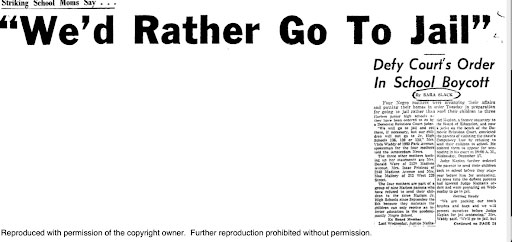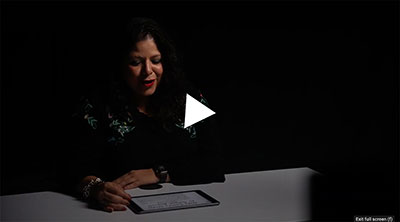“We’d Rather Go to Jail.”

Date: Dec 13, 1958
Caption: This Amsterdam News article was published on December 13, 1958. The headline, “We’d rather go to jail,” is a quote from Mrs. Viola Waddy, a Black mother in Harlem who refused to allow her child to attend a segregated and unequal school. Waddy and others risked imprisonment for that decision.
In 1958, one year after nine Black students made national and international news when they desegregated Little Rock Central High School in Little Rock, Arkansas, desegregation activists in Harlem organized their own protest. Nine mothers in Harlem decided to keep their children out of local junior high schools to protest both segregation and the conditions in those schools. They knew that their children’s schools had poorer facilities, a more limited curriculum, and more unlicensed teachers than the city’s segregated white schools. The press called these parents the “Harlem Nine,” echoing how the Little Rock students had been called the “Little Rock Nine.”1
One of the boycotting parents was Mae Mallory. In 1957, Mallory appeared at a public hearing of the Board of Education to accuse them of operating segregated schools. She compared her daughter’s schooling in Harlem to her own experience as a student in segregated Macon, Georgia. The Harlem school was “just as ‘Jim Crow’ as the Hazel Street School that I attended in Macon, Georgia,” she said.2 Mallory knew that many people at the time used the ‘Jim Crow’ label to describe racial segregation in the South, but she used it to draw attention to the fact of segregation in Harlem, New York City, and the North as well.
In October 1958, Mallory and other parents filed a lawsuit against the city, seeking $1 million in damages and accusing the Board of Education of working with “sinister and discriminatory purpose in the perpetuation of racial segregation in five school districts in Harlem.”3 While the lawsuit proceeded slowly in court, they decided to take a more public action - a boycott.
At the start of the boycott, fifteen parents were participating. They partnered with the Reverend Eugene Callender, a Harlem minister, to ensure their children would still receive an education while not in school. Reverend Callender offered his church as a place where students could take classes. Volunteer teachers, and the boycotting parents’ lawyer and his wife, taught the children English, math, social studies, world events, music, French, and art appreciation. However, the boycotting parents soon realized that offering their children this replacement schooling meant that the Board would not prosecute them for keeping their children out of school and therefore violating the state’s compulsory education law. They knew that their cause would draw more attention if they were taken to court.
Therefore, to make their protest more public and force the city to act, the parents ended the private tutoring, choosing no schooling at all for their children over segregated and unequal schooling. Some of the parents chose not to continue in the boycott at this point. The Amsterdam News article also mentions that some students had transferred to different schools. One of these, P.S. 622, was a “600 school,” described here.
As the boycotters predicted, the Board of Education brought the Harlem Nine to court for violating the law. In the first group of cases, the judge ruled in favor of the Board. However, in a separate trial, some of the mothers encountered a judge who understood the issue differently and supported the parents’ protest.
As an activist involved in many political struggles, Mae Mallory faced risks beyond the threat of fine or imprisonment for keeping her children out of school. Mallory, like Lucile Spence and some other Harlem education activists, had been affiliated with the Communist Party. In keeping with strong anti-communist sentiment at the time, Mallory was monitored by the FBI and harassed by various city agencies. Despite these threats, she continued her activism. After the boycott, she made a trip to North Carolina to support Freedom Riders working to desegregate transportation. While there, she was framed by FBI agents and accused of kidnapping. She spent years in prison in Cleveland, before leaving the US.4
-
For more on the “Little Rock Nine,” see Lonnie Bunch, “The Little Rock Nine,” National Museum of African American History and Culture, Smithsonian Institution, https://nmaahc.si.edu/blog-post/little-rock-nine. ↩︎
-
Adina Back, “‘Exposing the ‘Whole Segregation Myth’: The Harlem Nine and New York City’s School Desegregation Battles,” in Freedom North: Black Freedom Struggles Outside the South, 1940-1980, ed. Jeanne Theoharis and Komozi Woodard (New York: Palgrave Macmillan, 2003), 70. ↩︎
-
“Harlem Parents File for Million,” The New York Times, October 29, 1958. ↩︎
-
Ashley Farmer, “Mae Mallory: Forgotten Black Power Intellectual,” Black Perspectives, June 3, 2016, https://www.aaihs.org/mae-mallory-forgotten-black-power-intellectual/. ↩︎
Watch a close reading of this document

Categories: K-12 organizing, community activism, parent activism
Tags: racist segregation, policing and the criminal legal system, protest, zoning and student assignment, court cases, women's activism, Black people
This item is part of "Mae Mallory and the “Harlem Nine”" in "Black and Latina Women’s Educational Activism"
Item Details
Date: Dec 13, 1958
Creator: Sara Slack
Source: New York Amsterdam News
Copyright: Under copyright. Used with permission.
How to cite: “We’d Rather Go to Jail,” Sara Slack, in New York City Civil Rights History Project, Accessed: [Month Day, Year], https://nyccivilrightshistory.org/gallery/rather-go-to-jail.
Questions to Consider
- The Amsterdam News used the term ““Harlem Nine”” to remind readers of the ““Little Rock Nine”” who desegregated Central High School in Little Rock, Arkansas one year earlier. How were the “Little Rock Nine” and “Harlem Nine” efforts similar, and different? How does the story of the “Harlem Nine” challenge your previous understandings of segregation and desegregation in the United States?
- How did the “Harlem Nine” expose segregation and inequality in New York City’s schools? What risks did they take? How do you think their children felt about their parents’ protests? What do you think about taking risks to fight for change that you care about?
- What does the “Harlem Nine” case, and especially the use of the courts to punish parents who were protesting segregated schools, show us about the connection between schools and law enforcement?
References
How to Print this Page
- Press Ctrl + P or Cmd + P to open the print dialogue window.
- Under settings, choose "display headers and footers" if you want to print page numbers and the web address.
- Embedded PDF files will not print as part of the page. For best printing results, download the PDF and print from Adobe Reader or Preview.
